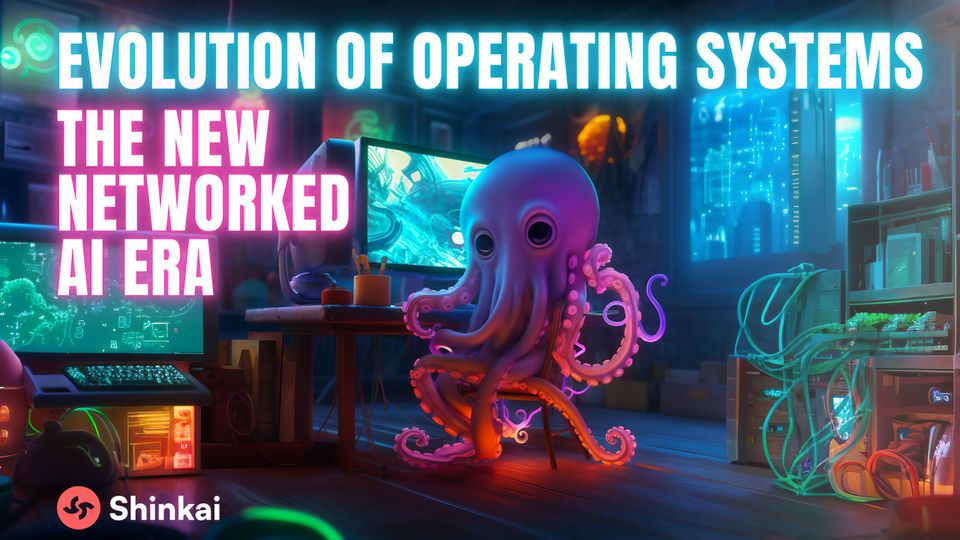Evolution of Operating Systems - The New Networked AI Era

The world of operating systems is far from static; it's a dynamic landscape that has continuously evolved to meet the ever-changing needs of its users and the expanding capabilities of hardware. If history has taught us anything, it's that the most successful operating systems have always been those that tapped into the zeitgeist of technological innovation and societal demands.
In the '60s and '70s, mainframe OSes like IBM's OS/360 employed techniques such as multiprogramming and spooling to manage computational workloads. These OSes utilized Job Control Language (JCL) scripts to orchestrate batch processes, marking a significant leap in task automation.They were emblematic of an era when computing was a luxury accessible only to institutions with deep pockets.
Then came the democratization of technology. The '80s and early '90s saw the rise of personal computing, where MS-DOS and early Windows took the baton. These OSes unlocked the power of computing for everyday people, leading to a boom in software development and the digitization of many aspects of daily life. PC adoption rates soared from just 8% of U.S. households in 1984 to more than 36% by 1997.
As the new millennium rolled in, UNIX and Linux-based systems adopted multi-threading and embraced POSIX standards for better interoperability. Web servers like Apache and Nginx became the linchpins, efficiently handling HTTP requests through event-driven architecture and asynchronous I/O. This shift was more than just a technological one; it represented a transition from localized to networked computing, making the internet an inseparable part of the OS experience. The speed at which websites proliferated is testament to this, with the number of websites growing from mere hundreds in 1993 to over 1.13 billion today.
Then, with the advent of smartphones, the battleground shifted yet again. By 2018, over 36% of the world's population owned a smartphone. Mobile operating systems like Android and iOS implemented resource-scheduling algorithms to prioritize foreground tasks while putting background tasks to sleep, optimizing CPU cycles and battery life. These OSes leveraged hardware-accelerated rendering for fluid touch interfaces, and employed sandboxing techniques to isolate application data, enhancing security.
Today's specialized operating systems for IoT and edge computing are being built with constraints like limited memory and low-power CPUs in mind. They often utilize Real-Time Operating Systems (RTOS) for deterministic task scheduling and support containerization to deploy applications seamlessly from your smart fridge to industrial robots. And here, we glimpse the horizon of what comes next—personal operating systems with decentralized architectures and deep AI integrations.
Why is this important? As our digital selves become more intertwined with our physical selves, control and ownership of that digital identity become paramount. Think of a personal OS that not only enables you to own your data but also employs AI agents to actively manage your professional tasks, such as scheduling meetings, and personal life, like recommending personalized fitness routines—all under a single decentralized system. Such a system would give you a level of data autonomy and intelligence currently unparalleled, taking the concept of user-centric design to the next level.
Understanding this evolution isn't just about appreciating technological advancements; it's about preparing for revolutionary changes that are right around the corner. It’s about envisioning a future where you're not just a consumer of technology but an empowered participant in a digital ecosystem that’s as complex and multifaceted as you are. The impending wave of AI-integrated, decentralized operating systems will not just manage software and hardware but will extend to becoming life-management systems, heralding not just a technological but also a societal metamorphosis.
Evolution of OSs through Time

Mainframes and Early Computing
Target: Enterprise, Scientific Computing
Examples: IBM OS/360, CDC SCOPE
Notable Features: These were specialized, expensive systems used for large-scale data processing. Often operated via batch processing, sometimes with time-sharing to maximize utilization.
Personal Computing Era
Target: Consumers, Small Businesses
Examples: MS-DOS, Apple DOS, early Windows versions
Notable Features: These OSes were simpler and aimed at making computing accessible to everyday people. They were generally single-user systems with limited networking capabilities.
Networked Computers & Workstations
Target: Enterprise, Academia
Examples: UNIX, SunOS, Novell NetWare
Notable Features: These were designed to perform complex tasks and facilitate networking, often used in academic research or enterprise settings for specialized applications.
Internet Age
Target: General-Purpose (Consumers & Enterprise)
Examples: Windows 95/XP, Linux distributions like Debian
Notable Features: Introduced internet connectivity as a core feature, and with the advent of graphical interfaces, became more user-friendly and capable.
Mobile Computing
Target: Consumers, later also Enterprise
Examples: Android, iOS
Notable Features: Optimized for touch interfaces, battery efficiency, and on-the-go internet connectivity.
Cloud Computing
Target: Enterprise, Developers
Examples: Google's Chrome OS, server variants of Linux
Notable Features: These OSes are optimized for internet connectivity and are often lightweight, relying on cloud storage and computing power.
IoT and Embedded Systems
Target: Specialized Industrial Applications, Consumer Goods
Examples: FreeRTOS, VxWorks
Notable Features: These are extremely lightweight OSes designed to run on devices with minimal computing power and often have real-time processing requirements.
Future: AI and Decentralized Systems
Target: Unifying AI into the rest of the computing stack with a focus on personal & decentralized control.
Examples: In-progress projects like Shinkai.
Notable Features: These next-gen OSes go beyond mere hardware and software management. They introduce new paradigms of data ownership, decentralized architecture, and deeply integrated AI functionalities with a global identity system.
Shinkai: Building the new AI Frontier
Shinkai represents a new paradigm shift by building an overlay OS that fully acknowledges that in the 21st century all of our digital lives are fully networked across numerous digital devices and will need to seamlessly slot in with AI Agents. Shinkai offers a peek into what the next stage of digital evolution might look like.
Large Language Models (LLMs) Backed Agents
Shinkai offers a Personal AI OS that uses LLMs to extend beyond mere user interfaces, weaving AI agents into the fabric of your daily digital life. Whether it's helping you write documents in Google Docs or facilitating crypto transactions, LLMs serve as personal assistants that can execute complex tasks across multiple platforms easily with your personal data (with baked-in privacy).
Fully P2P Networked AI Agents
Inspired by the internet’s success in networking personal computers, Shinkai aims to network LLMs globally. This enables your AI agents to interact with other agents, devices, and even your friends, revolutionizing the way tasks are coordinated and executed.
Seamless Crypto Integration
Shinkai is not just a step forward in the Web2 world, Shinkai is also deeply integrated into the Web3 ecosystem. It incorporates blockchain technology to ensure decentralization from day one, unlocking innovative avenues like AI-driven DeFi protocols and more.
Data Autonomy in a Decentralized World
Shinkai places a premium on individual data ownership and control, all built on a decentralized architecture. This empowers users to truly own their digital identities and provides a counter-approach to the data monopolies of Big Tech companies.
Interoperability and Versatility
Shinkai is designed to be platform-agnostic, suitable for traditional personal computing environments, IoT devices, and even enterprise. This universal adaptability makes it fully prepared for the forthcoming era of hyper-connected, intelligent ecosystems.
Through its AI and decentralized capabilities, Shinkai promises not just an upgrade but a complete reimagining of how users interact with their computers & devices on a day-to-day basis. Understanding this evolution means preparing for the upcoming computing future.
With Shinkai, we're building a Personal AI OS with the aim to define the next era of computing, just like iOS and Android did for the last 20 years. Stay tuned by subscribing and following.

